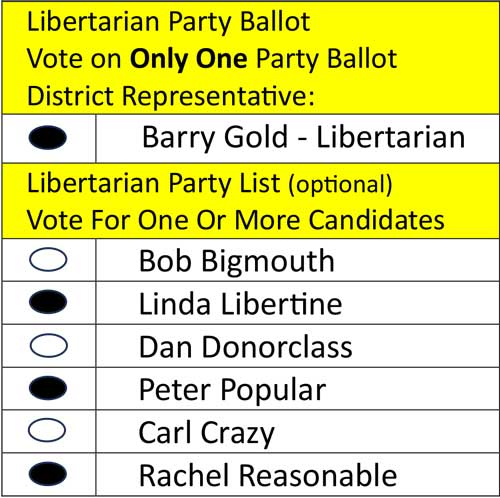Mixed Member Proportional Representation (MMP)
Preserve Single-Member Districts with Open Party List MMP
Voters decide how many seats each party wins in Mixed Member Proportional (MMP) elections. A party with 25% of the vote wins 25% of the seats.
We elect our representatives from traditional single-member districts. We also elect at-large members to balance party representation.
The chief rival of MMP is multi-member districts (MMDs). Proportional accuracy suffers because at-large seats are not used with MMDs. A legislature with less than five members per seat is only semi-proportional, worse if the legislature is small.
Single Member Districts
Single-member districts have valued benefits. We know our representative, perhaps personally. We have an advocate for problems, requests, and complaints. Our rep knows what we want and need in our community. Candidates campaign close to home; officeholders work for their neighbors. Single-winner ballots seldom have too many candidates. We are reluctant to give up these advantages.
MMP is Easy
Step 1 – Vote for Your District Representative
Step 2 – Vote for At-large Members on the Party List below the candidate you voted for.

Party Votes and Party Lists
When you vote for a district representative you also cast a Party Vote for that candidates political party. Party Votes decide how many seats each party wins.
Then vote for the Party List candidate(s) you prefer. This should be optional; if you do not know the candidates, just vote for your district representative.
When a party wins at-large seats, the candidates with the most Party List votes serve as at-large representatives.
Approval Voting is one of several good options for party list voting. Fair and easy to use; vote for the candidates you like on the ballot above.
How Many At-large Seats?
Most MMP legislatures have a set number of at-large seats. To ensure fair proportional representation (PR), a legislature with 100 single-member districts needs 50 or more at-large seats. Small legislatures need a higher percentage of at-large seats, large ones lower.
Consider the election of a 150-seat legislature with 100 districts seats and 50 at-large seats. If Party A wins 40 district seats and receives 33.3% of the Party Vote, Party A would win 50 seats (33.3% of 150 seats); 40 district seats plus 10 at-large seats. This example is nice and neat. In real elections, an apportionment method like Highest Averages is used to deal with the fractions.
If small parties win 30% of the Party Vote (combined) but no district seats, the legislature must be at least 30% at-large. If third parties win district seats less at-large seats will be needed for proportional accuracy.
High party thresholds, like a 3% Party Vote minimum or a 3-seat minimum, reduce at-large seats. Most PR systems have thresholds. Cutting small party representation is less proportional.
Base Ratio Method* for Accurate Proportional Representation (PR)
Accurate PR with a minimum number of at-large seats can be achieved using the Base Ratio Method. The downside, the number of at-large seats would change with each election. A legislature with 100 district representatives may need 15 to 35 at-large seats. The Base Ratio Method is simple, it uses basic math.
For details, please visit Base Ratio Method for accurate proportional representation.
Regional Party Lists
To give voters a genuine choice among party-list candidates, open party lists need at least 50% more candidates than the maximum number of at-large seats the party might win.
Long party lists overwhelm voters. Regional party lists keep the lists short. Each regional list would cover several districts.
When apportioning at-large seats, party representation is the prime criteria. A party’s at-large seats could be reassigned to achieve a regional balance of seats. However, the total number of at-large seats won by each party must not be changed. We hope to cover these issues in a future article.
Party List Primary Elections
To promote voter participation, we should give each party a choice between open, semi-open, or closed party list primaries.
Major parties gain publicity and ballot access in the primaries. Fairness requires third-parties to be treated equally.
Proportional Representation for America
PR will be a game changing improvement to our political system. We will gain true representation. All elections will be competitive; our votes will not be wasted. We will neutralize the spoiler effect and slash gerrymandering. Voters and politicians will have more political parties to choose from.
Candidates will expand their appeal with positive campaigns. Negative campaigns will risk punishment from voters. Officeholders will have incentives and opportunities to build coalitions and negotiate compromises. We will be heard. We will have more power. Voters will be in charge.
To learn more about reducing the number of at-large seats please visit the
Base Ratio Method page.
*We invented the term “Base Ratio Method” because it is descriptive. There may be an existing term for it, please inform us if you know of one.


